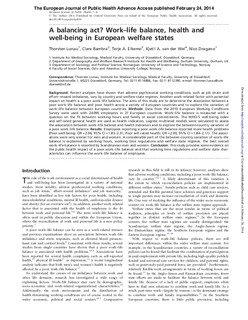| dc.contributor.author | Lunau, Thorsten | |
| dc.contributor.author | Bambra, Clare | |
| dc.contributor.author | Eikemo, Terje Andreas | |
| dc.contributor.author | van Der Wel, Kjetil A. | |
| dc.contributor.author | Dragano, Nico | |
| dc.date.accessioned | 2015-02-03T06:44:21Z | |
| dc.date.accessioned | 2016-04-12T14:24:48Z | |
| dc.date.available | 2015-02-03T06:44:21Z | |
| dc.date.available | 2016-04-12T14:24:48Z | |
| dc.date.issued | 2014 | |
| dc.identifier.citation | European Journal of Public Health 2014, 24(3):422-427 | nb_NO |
| dc.identifier.issn | 1101-1262 | |
| dc.identifier.uri | http://hdl.handle.net/11250/2385349 | |
| dc.description.abstract | Background: Recent analyses have shown that adverse psychosocial working conditions, such as job strain and effort–reward imbalance, vary by country and welfare state regimes. Another work-related factor with potential impact on health is a poor work–life balance. The aims of this study are to determine the association between a poor work–life balance and poor health across a variety of European countries and to explore the variation of work–life balance between European countries. Methods: Data from the 2010 European Working Conditions Survey were used with 24 096 employees in 27 European countries. Work–life balance is measured with a question on the fit between working hours and family or social commitments. The WHO-5 well-being index and self-rated general health are used as health indicators. Logistic multilevel models were calculated to assess the association between work–life balance and health indicators and to explore the between-country variation of a poor work–life balance. Results: Employees reporting a poor work–life balance reported more health problems (Poor well-being: OR = 2.06, 95% CI = 1.83–2.31; Poor self-rated health: OR = 2.00, 95% CI = 1.84–2.17). The associations were very similar for men and women. A considerable part of the between-country variation of work–life balance is explained by working hours, working time regulations and welfare state regimes. The best overall work–life balance is reported by Scandinavian men and women. Conclusion: This study provides some evidence on the public health impact of a poor work–life balance and that working time regulations and welfare state characteristics can influence the work–life balance of employees. | nb_NO |
| dc.language.iso | eng | nb_NO |
| dc.publisher | Oxford University Press | nb_NO |
| dc.title | A balancing act? Work-life balance, health and well-being in European welfare states | nb_NO |
| dc.type | Journal article | nb_NO |
| dc.type | Peer reviewed | nb_NO |
| dc.date.updated | 2015-02-03T06:44:21Z | |
| dc.source.volume | 24 | nb_NO |
| dc.source.journal | European Journal of Public Health | nb_NO |
| dc.source.issue | 3 | nb_NO |
| dc.identifier.doi | 10.1093/eurpub/cku010 | |
| dc.identifier.cristin | 1120905 | |
| dc.relation.project | Norges forskningsråd: 217145 | nb_NO |
| dc.description.localcode | © The Author 2014. Published by Oxford University Press on behalf of the European Public Health Association. All rights reserved. | nb_NO |
